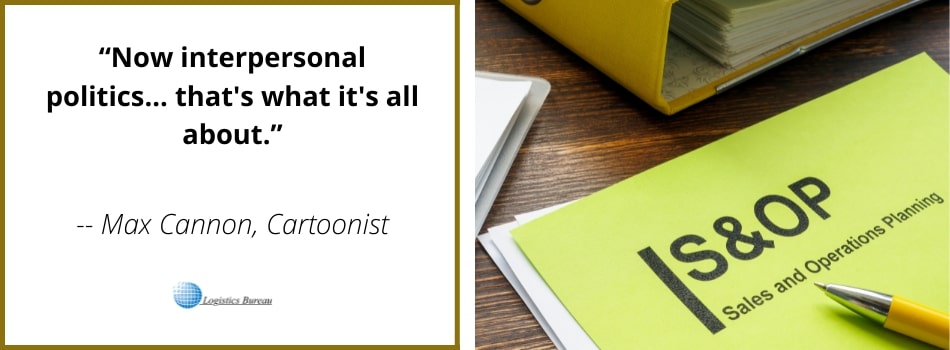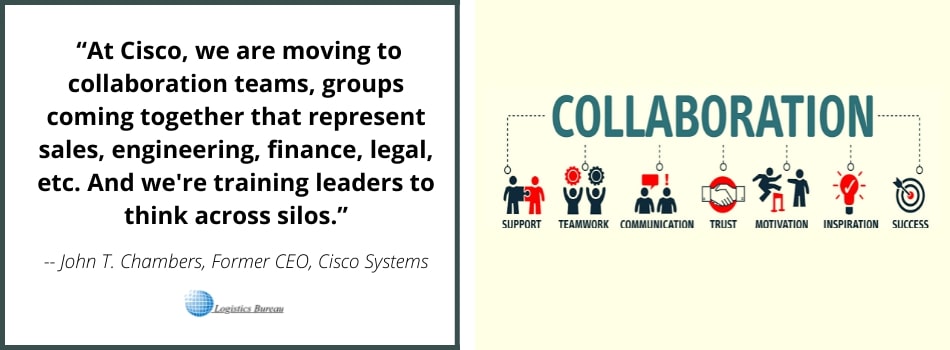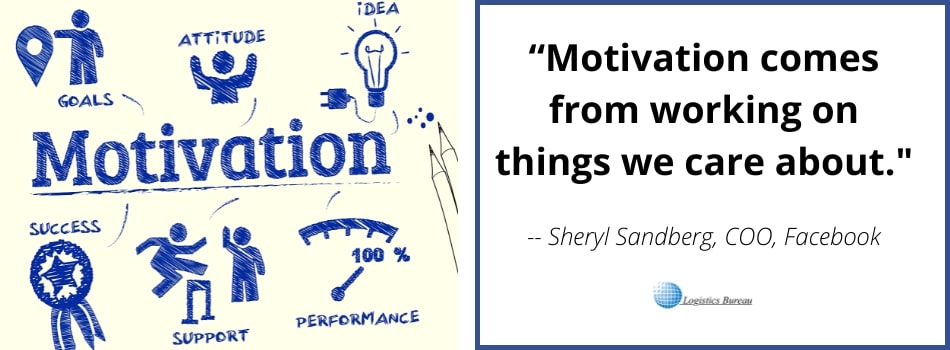Has your company ever suffered problems with, implemented, or even considered implementing a sales and operations (S&OP) planning process? If so, a few minutes of online research will reveal what you probably suspected deep down all along—that there are real risks involved, which can stand in the way of promised benefits.
But what makes it so challenging to implement S&OP successfully?
Often, in our experience, the problem is a human one… It’s not the data, not the process, not the technology, or the strategy, but the people.
In this article, we’ll explain why that should be and how your company can avoid S&OP problems by investing correctly in the people and their interrelationships, without which it’s simply impossible to tie the moving parts of S&OP together.
Why S&OP Needs a Lot of Human Investment
Pundits typically emphasize data and digital technology when proselytising for the S&OP concept. Often, there’s a misguided belief that when the process goes wrong, the business erred by failing to invest in the correct software or did not manage data correctly. While that may be true, these issues are still the result of a human decision-making process.
More to the point, though, for S&OP to be effective, it matters not whether a company uses Excel spreadsheets or the latest best-of-breed sales and operations planning software.
What matters most is how effectively the people involved in the process collaborate and overcome the silo mentality prevalent in organisations with multiple functions and business units.
That’s because S&OP is a process involving many participants who must all pull together to pursue a common goal. To elaborate, let’s look now at those participants and their roles in sales and operations planning.
Who’s Who in the S&OP Process?
The Demand Planner
The demand planner will typically take the lead in gathering data relating to historical sales trends, a crucial early step in the planning process.
The demand planner must engage sales, marketing, finance, and logistics colleagues to gather the required data. He or she must work closely with these stakeholders to ensure the collation of accurate demand statistics.
The demand planner will also be responsible for using this data to develop demand forecasts and plans, which will then need to be translated into supply plans. So it’s easy to see how vital it is for the demand planner to communicate and collaborate effectively with the functional stakeholders who own the necessary data.
The Supply Chain Head
We use the term Head of Supply Chain simply because it’s a role that falls under a range of professional titles. So, for example, the Head of Supply might be the Supply Chain Director, Supply Chain Manager, or another non-executive supply chain management specialist.
Whomever this person might be, they are responsible for creating a supply plan in the S&OP process. While this task will draw heavily on the demand plan, the Supply Chain Head will also need to canvas input from the company’s finance, logistics, operations, and manufacturing functions.
The other critical role of the Supply Chain Head is to execute and lead the monthly S&OP meetings. The first of these is the pre-S&OP meeting, during which teams on the supply and demand side, typically comprising sales, marketing, finance, operations, and logistics representatives, will reconcile the demand and supply plans.
The second is the executive meeting, attended by the executive sponsor (see below). That is the forum at which the demand and supply plans will be approved and released for execution.
The Executive Sponsor
The need for any S&OP process to have an executive sponsor who actively participates in the process, albeit only by exercising final approval over plans and, of course, making any decisions that call for executive authority, cannot be overstated.
The executive sponsor could be the company’s Chief Operating Officer, Supply Chain Officer, or CEO. In any case, he or she will—aside from signing off the demand and supply plans—ensure that each function in the S&OP process is accountable for playing its part. The executive sponsor will also serve as an arbiter in case of disputes.
This last role is essential as S&OP is a process requiring cooperation among functions with sometimes conflicting objectives, so disagreements and misunderstandings will inevitably arise on occasion.
Marketing and Sales Head(s)
S&OP is impossible without sales forecasts, and the head(s) of sales and marketing must make sure that those forecasts happen regularly, meaning monthly or according to some other periodic schedule.
The heads of the sales and marketing departments are also the ones who schedule sales events and promotions. Therefore, they must participate in the monthly S&OP meetings and keep other stakeholders informed about upcoming activities and events.
They must also work with the other functional teams to ensure that promotions and similar activities can be executed without placing undue strain on the supply chain.
Finally, the marketing and sales head(s) must continuously seek to improve the accuracy of forecasts, which in turn enhances the potential of S&OP to deliver targeted benefits for the business.
Other Stakeholders
In addition to those people mentioned above, other functional staff involved directly in the sales and operations planning process might include supply planners or schedulers, sales personnel, operations leads, and production planners.
It’s becoming increasingly common for the finance team to participate in the S&OP process, too, especially during the pre-S&OP and executive S&OP meetings. In some companies, finance is considered so critical to the process that the CFO is the person representing finance at monthly sales and operations planning meetings.
With so many parties involved in the process, it’s understandable that aligning them on the goals and benefits of S&OP might be challenging.
Apart from anything else, there is one thing that each of the stakeholders has in common with their peers. That shared quality is called humanity and comprises phenomena such as feelings, emotions, values, ideals, agendas, and biases.
S&OP is ostensibly a numbers game, of course. However, many of its problems arise from failure to harness the best of the human condition. Unfortunately, among leaders, there is also a tendency to underestimate the impact of such a failure.
Let’s move on, then, to look at how problems relating to people can make S&OP a challenging process to implement and maintain effectively.
Common S&OP People Problems
While successful sales and operations planning is undoubtedly a boon to any business, its very nature and dependence on correct human behaviour render it challenging to achieve.
For example, S&OP is hardly motivational because it doesn’t appeal to the professional interests of individuals in any specific function or department other than operations/supply chain management. And if a process doesn’t motivate, it’s hard for people to engage with it.
Furthermore, S&OP requires cross-functional collaboration to meet goals more significant than those of any individual function or department, which may even conflict with some functional objectives.
Hence, there is a need to ensure that everyone involved in S&OP can see beyond their immediate horizons to understand the big picture. Success depends upon a business culture where cross-functional collaboration receives more than mere lip service from stakeholders.
The need for effective change management is often overlooked when introducing S&OP to an organisation. However, it is a vital preparation activity.
When our consultants commence an S&OP engagement with a client company, they place change management and cultural transformation among their highest initial priorities. Moreover, it’s affordable for them to do so, since our extensive experience in implementing sales and operations planning enables us to apply powerful techniques to fast-track cross-functional adoption and promote collaboration.
In addition to these concerns, though, there is a range of more specific issues relating to people that can typically obstruct an organisation’s efforts to implement sales and operations planning. Here are five of them.
1. Poorly Defined Goals
When Logistics Bureau’s consultants embark on engagements to help clients with S&OP, one of the common initial findings is that the organisation has not set down and shared any clearly defined goals for the process.
S&OP can deliver several benefits, but that knowledge is not enough to encourage disparate business functions to overcome conflicts and buy into the process. Instead, it is essential to spell out precisely what you plan to achieve by implementing sales and operations planning.
The imperatives for one company will not be the same as another’s. Therefore, you must engage your business teams in the effort by aligning them toward specific achievements.
Of course, the goal(s) might change over time, such as when existing ones are achieved, but that is fine. The critical thing is not to sell S&OP based on some woolly benefits but as a road towards something tangible and measurable.
2. Shortage of Emotional Aptitude
We’ve already mentioned the role of emotions in the S&OP process, but how do people’s feelings and emotions affect it specifically? To understand that, we must first recognise that many of the emotional qualities required for successful S&OP are not naturally present across the functions of an enterprise or organisation.
Indeed, the human challenges of S&OP link closely to other problems arising from silos in business, an area in which many leaders encounter difficulties.
However, some cross-functional activities and objectives are more straightforward to bring to fruition than others. Typically, S&OP is one of the harder ones.
The reasons for this are twofold. Firstly, silos are comfortable places for humans, even dedicated business professionals, and crossing silos means stepping out of the comfort zone.
Secondly, getting people to cross silos is even more problematic when they perceive that it obstructs progress within their vertical hierarchies, which S&OP appears to do because people must disregard departmental goals in favour of its overarching cross-functional objectives.
The Importance of Readiness Assessment
In many companies, there are not enough people with sufficient emotional aptitude to bravely shed their silo mentalities and step up to the S&OP plate.
As a result, when trying to maintain an S&OP process, these companies struggle to align teams harmoniously toward cross-functional objectives. That’s if they have even defined those objectives.
To overcome this problem, companies must invest in a readiness assessment before even considering commencing an S&OP process.
If it’s found that sufficient emotional aptitude is not present, an effective program of focused training, development, and perhaps even recruitment will be necessary to achieve a critical mass of people with the emotional aptitude to understand and commit to attaining S&OP goals.
3. Errors in Leadership
Sadly, this one is somewhat pervasive and manifests in many S&OP weaknesses. In a process so reliant on people, solid and dedicated leadership is a vital prerequisite. But commonly, because S&OP involves so many functional departments, including sales, marketing, and finance, an executive from one of these functions is chosen to lead an S&OP process.
Even these days, when supply chain management’s business criticality is more widely understood, sales, marketing, or finance leaders may still have minimal supply chain knowledge. That makes them a less-than-ideal choice to take charge of sales and operations planning. As a result, such leaders often have difficulty driving the process and successfully engaging stakeholders from all functions.
But even if you choose a supply chain or logistics leader to head up your S&OP process, leadership mistakes can still stand in the way of results.
S&OP Leadership Errors to Avoid
Typical mistakes made by even the best in S&OP leadership include:
- Ignoring the need to cross-train and focus on developing emotional aptitude
- Neglecting to set clear and measurable objectives for the S&OP process
- Failing to implement S&OP-specific KPIs to track performance and progress toward goals
- Trying to maintain a textbook standard S&OP approach without tailoring it to specific business circumstances
We’ve already covered the first two mistakes mentioned above, but the latter two bear some explanation.
Failure to Implement KPIs
When the leader(s) of an S&OP implementation neglects the need for a system of measurements, relevant to the performance of the process itself, they cannot lay the blame at the feet of technology or process design. It is a human failing.
Furthermore, by neglecting to measure performance, they fail to provide all the other people involved in the process with a framework of guidance necessary to promote cohesion and progress toward the shared S&OP goals.
Is yours one of those companies that haven’t planned for KPIs to measure a new S&OP process, or are you already running S&OP without KPIs? In either case, we strongly recommend that you implement the following metrics, or similar, to help your teams steer the course and benefit from performance visibility:
- Demand and production forecast accuracy
- Delivered on time and in full (DIFOT)
- Supply chain cycle times
- Inventory turns
- Warehouse capacity utilisation
Of course, it’s possible that you already have some of these KPIs in place to monitor supply chain performance (you certainly should), but you may not yet have applied them as metrics to monitor S&OP performance. If that’s the case, now is the time to start.
The Folly of S&OP Standardisation
One of the problems with concepts such as S&OP is that they often emerge with guidelines from their creators, which later evolve into seemingly rigid doctrines, albeit with numerous variants.
For example, several sales and operations planning models exist, including those credited to Tom Wallace and Oliver Wight. Still, none are suitable for strict implementation as standard one-size-fits-all processes.
Instead, your strategy should be to take the principles of whichever S&OP model seems to fit best, and then adapt the process to your business strategy and objectives.
Companies that enjoy genuine success with S&OP understand this, as do their sales and operations planning leaders. The largest of these companies might even run several discrete S&OP processes, each tailored to a specific business unit, region, product range, or customer segment, for example.
Design and Customise to Suit Your Operation
While it might seem that erroneously trying to standardize S&OP is a process issue, prompting you to wonder why we’re mentioning it in an article about human factors, remember that we’re talking, here, about the leaders, who, after all, are responsible for determining the process.
Therefore, the solution is to assign the most suitable people to the S&OP leadership roles—people who understand the need to customise the process and, for instance, to measure process performance.
A desire to avoid inappropriate standardisation is one of the primary reasons companies regularly engage Logistics Bureau to help implement or improve S&OP processes. Our team has the benefit of years of experience in sales and operations planning and knows how to analyse your business needs and develop a process that’s aligned perfectly with them.
4. Excluding Key People or Teams
At the beginning of this article, we looked at who’s who in the S&OP process. At that point, we mentioned not only the key individuals but also discussed how participation from sales, marketing, logistics, finance, production, and operations teams was essential to complete the entire cross-functional cohort required to run S&OP successfully.
Sadly, in our experience, many companies neglect to involve the full range of functions in the S&OP process.
For example, we have seen instances where the marketing team was not involved in S&OP (which meant promotional campaigns were often launched without communication between the marketing and inventory management teams—a surefire way to experience stock-outs and upset customers). Even worse, in some businesses we worked with, the logistics team was uninvolved in S&OP.
With people from a business’ key functions omitted from the S&OP process, benefits justifying the considerable effort involved in sales and operational planning are unlikely to be fully realised.
5. Reluctance to Let Technology Take the Strain
This last error on our list is an interesting one. Indeed, it might seem counter to everything we’ve been saying throughout the article. After all, we have espoused people’s importance to the S&OP process and played down the position that technology (or the lack of it) is a more common cause of sales and operations planning challenges.
However, people are fallible and possess all of those imperfections we mentioned early on in this post—emotions, feelings, biases, and so on. These “human” flaws make people less than ideal for data management and manipulation, the other essential ingredient in sales and operations planning.
Many organisations more successful with S&OP have learned to balance the workload distribution between humans and machines.
Conversely, many companies that struggle with S&OP do so because they are still limping along with Excel spreadsheets and the barest minimum in data management automation.
The moral of the story is this: to be successful with S&OP, do all you can to free your people to make smart decisions in the process, which means automating as much data management and analysis as possible.
The People of S&OP: 7 Golden Rules to Get the Best From Them
Instead of taking the commonly favoured position that technology or process management are the most likely points of weakness, this article has deliberately emphasised how people can obstruct the S&OP process.
In a future article, we might dwell more comprehensively on how to avoid the mistakes discussed here. For now, though, let’s conclude with a summary of tenets to follow if you want to prevent or eliminate S&OP problems of which people are the root cause.
In short, if you adhere to the following golden rules, your risk of running into people-related problems will be minimised:
1) Ensure that representatives from sales, marketing, logistics, finance, production, procurement, and operations functions are permanent participants in the S&OP process.
2) Deploy digital technology as much as possible to manage S&OP data. Your people should be able to focus primarily on collaboration and decision-making.
3) Make sure that the goals for your S&OP process are clearly defined and that everyone understands them.
4) Establish relevant KPIs to enable your S&OP stakeholders to track progress and measure performance.
5) Gather a critical mass of people with the emotional aptitude to overcome silo mentality and embrace cross-functional collaboration.
6) Appoint an S&OP executive leader who has an in-depth understanding of supply chain management and knows the ins and outs of your company’s supply chain.
7) Do not let your management team try to implement S&OP as a standard process straight out of the textbook. Instead, impress upon them the need to adapt protocols to suit your organization’s needs.
For Smooth S&OP, Let Our People Help Your People
When you think about it, it’s almost impossible for S&OP failures to arise from poor technology or data. In reality, those issues are merely symptoms.
The root causes are nearly always related to human weaknesses. But they are weaknesses that your company and its people can overcome, or for which you can compensate. It all starts with awareness.
When you engage Logistics Bureau to help you with S&OP, you know you’ll receive support from a team that possesses the necessary awareness and knows how to integrate people, technology, and process to the best possible effect, by dint of engagement in countless sales and operations planning projects.
We’ll work with you, either remotely, at your premises, or with a combination of remote and on-site activity, to ensure your S&OP process is sound and delivers the benefits that it should, and certainly can, achieve.
To learn more about how we can help you with sales and operations planning, please visit our S&OP service page, where you can also arrange an initial FREE consultation call with one of our experts.
Editor’s Note: The content of this post was originally published on Logistics Bureau’s website dated August 02, 2022, under the title “Sales and Operations Planning: The Interpersonal Element”.









